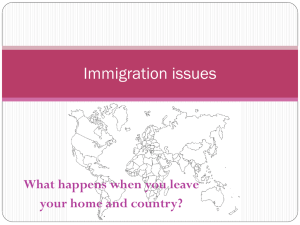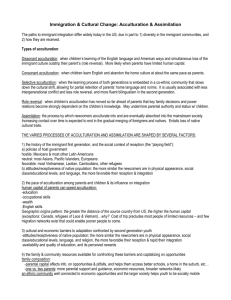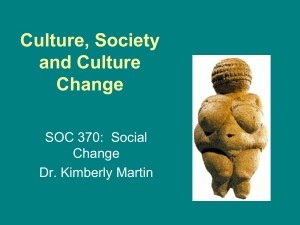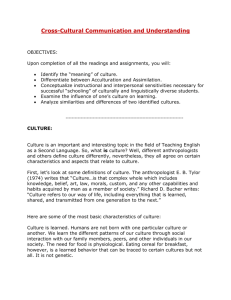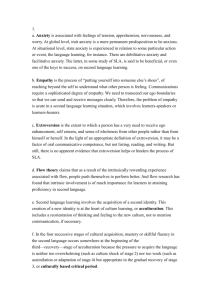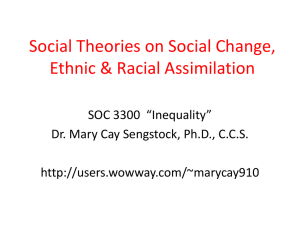Tongue Tied - Heritage University
advertisement
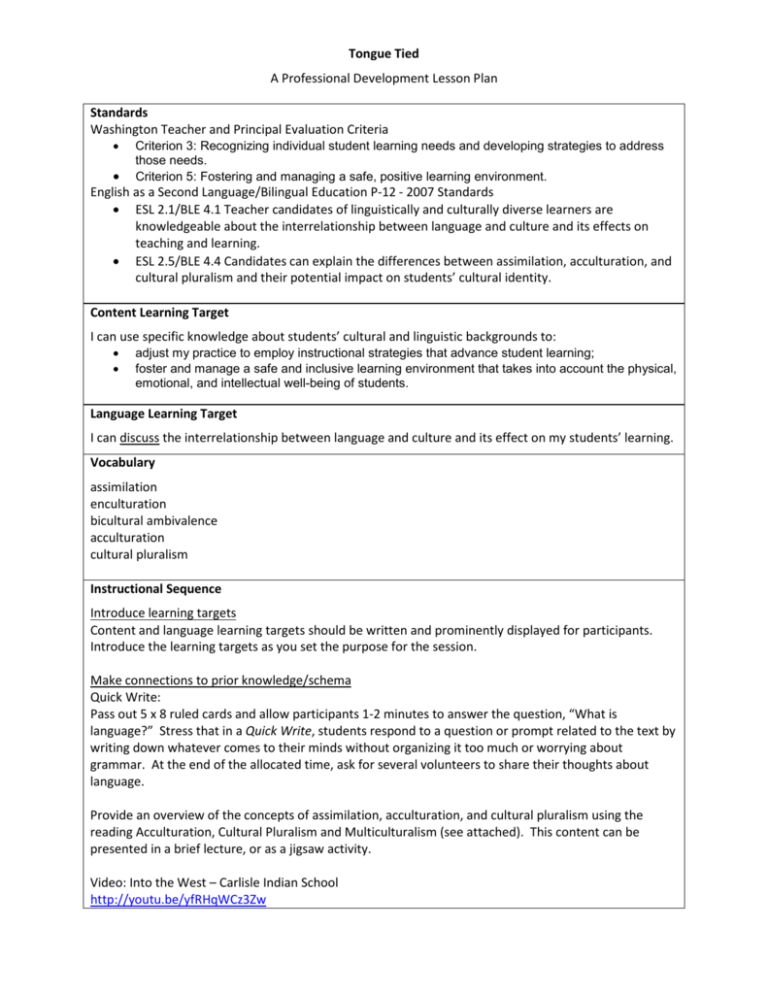
Tongue Tied A Professional Development Lesson Plan Standards Washington Teacher and Principal Evaluation Criteria • Criterion 3: Recognizing individual student learning needs and developing strategies to address those needs. Criterion 5: Fostering and managing a safe, positive learning environment. • English as a Second Language/Bilingual Education P-12 - 2007 Standards • ESL 2.1/BLE 4.1 Teacher candidates of linguistically and culturally diverse learners are knowledgeable about the interrelationship between language and culture and its effects on teaching and learning. • ESL 2.5/BLE 4.4 Candidates can explain the differences between assimilation, acculturation, and cultural pluralism and their potential impact on students’ cultural identity. Content Learning Target I can use specific knowledge about students’ cultural and linguistic backgrounds to: • • adjust my practice to employ instructional strategies that advance student learning; foster and manage a safe and inclusive learning environment that takes into account the physical, emotional, and intellectual well-being of students. Language Learning Target I can discuss the interrelationship between language and culture and its effect on my students’ learning. Vocabulary assimilation enculturation bicultural ambivalence acculturation cultural pluralism Instructional Sequence Introduce learning targets Content and language learning targets should be written and prominently displayed for participants. Introduce the learning targets as you set the purpose for the session. Make connections to prior knowledge/schema Quick Write: Pass out 5 x 8 ruled cards and allow participants 1-2 minutes to answer the question, “What is language?” Stress that in a Quick Write, students respond to a question or prompt related to the text by writing down whatever comes to their minds without organizing it too much or worrying about grammar. At the end of the allocated time, ask for several volunteers to share their thoughts about language. Provide an overview of the concepts of assimilation, acculturation, and cultural pluralism using the reading Acculturation, Cultural Pluralism and Multiculturalism (see attached). This content can be presented in a brief lecture, or as a jigsaw activity. Video: Into the West – Carlisle Indian School http://youtu.be/yfRHqWCz3Zw Tongue Tied A Professional Development Lesson Plan Table Talk: Prepare participants for the first activity by posting Accountable Talk (academic discourse)poster or provide table mats with sentence stems (see attached) to guide their discussion. Remind participants that everyone in the group has something important to contribute. Distribute a card to each table group containing one of the following questions: • How is language tied to our identity? • What are some positive ways we use language? • What are some negative ways we use language? • How are language and power related? • How might language be considered cultural capital? Allow 5-7 minutes for table groups to discuss the question on their cards. During the last minute of discussion, ask groups to select a group member to share a brief summary of their discussion with the whole group. (Option – Groups may record their answers on chart paper and participate in a Gallery Walk activity to review and comment on all five questions.) Exit Ticket: List three things we can do in our schools to affirm students’ cultural and linguistic heritage. Consider and be explicit about: • Classroom environment • Instructional strategies • Connections with home and community Extension Activities Read the poem “Cut into Me” by Carole Yazzie Shaw and write a letter to the author. Write a Six Word Poem about language and identity. Tongue Tied A Professional Development Lesson Plan Accountable Talk Sentence Starters Asking for Clarification • Could you repeat that? • Could you give me an example of that? • I have a question about that: …? • Could you please explain what _______________ means? • Would you mind repeating that? • I’m not sure I understood that. Could you please give us another example? • Would you mind going over the instructions for us again? • So, do you mean . . . ? • What did you mean when you said …? • Are you sure that …? Expressing an Opinion • I think/believe/predict/imagine that . . . . • In my opinion . . . . • It seems to me that . . . . • Not everyone will agree with me, but . . . . Responding • I agree with what ______________ said because . . . . • You’re right about that, and I also think . . . . • That’s an interesting idea. I wonder . . .? I think. . . . Do you think . . .? • I thought about that also, and I’m wondering why . . .? • I hadn’t thought of that before. You make me wonder if . . . ? Do you think . . .? Disagreeing • I don’t really agree with you because . . . . • I see it another way. I think . . . . • My idea is slightly different from yours. I believe that . . . . I think that . . . . • I have a different answer than you. . . . Soliciting a Response • Do you agree? • _____ (name), what do you think? • We haven’t heard from YOU yet. • _____ (name), what did YOU understand from that answer? From Avid – Socratic Seminars Tongue Tied A Professional Development Lesson Plan Acculturation, Cultural Pluralism and Multiculturalism Acculturation vs. Assimilation Acculturation and assimilation are two very important concepts in sociology and anthropology that describe cross cultural effects on both minorities as well as majorities in societies that are multi ethnic and multicultural in nature. Assimilation is a broader concept as described by sociologist Jean Piaget and refers to the manner in which people take new information. There are many people who think of the two concepts as same and even use them interchangeably. However, this is not correct as there are subtle differences that will be pointed out in this article. Acculturation If you belong to a minority community in a country and retain your own culture but cannot remain isolated and are affected by the majority culture in such a way that you adapt to some aspects of the majority culture, the process is referred to as acculturation. It can be said that the individual, or for that matter, most of the members of this community are bicultural. It so happens that the original customs remain, and the members of the community accept customs from the majority community. In a multi ethnic society such as US, a person who is Hispanic or has Chinese roots remains attached to his own culture while adapting and accepting some of the customs of the whites. Meeting of cultures is never a one sided process as many believe and, though a person belonging to a minority culture may begin to dress and speak like those belonging to the majority culture, he still retains the beliefs and customs of his own culture thus reflecting the process of acculturation. Acculturation process has many outcomes of which important ones are assimilation, rejection, integration, and marginalization. The importance of acculturation can never be overemphasized in the study of cross cultural influences and the ways peoples of different ethnic identities learn to adapt and accept the cultural traits of a majority community in a multiethnic society. Assimilation Assimilation is a process whereby people of a culture learn to adapt to the ways of the majority culture. There is a loss of one’s own culture as a person gives more value to the cultural aspects of the majority community in the process of assimilation. This has been the case in the United States that has been the centre of attraction of immigrants from many different countries. When the original customs and traditions of a culture get lost when it is influenced by the majority culture of a country, the process is referred to as assimilation. Assimilation is the process that inevitably takes place whenever there are immigrants arriving in a country from a foreign land. Assimilation is a process that can be in degrees, and full assimilation is said to have taken place when it becomes hard to tell that the person belongs to a minority culture or is from the majority culture. What is the difference between Acculturation and Assimilation? • Meeting of cultures always produces results in terms of changes in both the cultures, and acculturation and assimilation refer to two important and different changes in these cultures. • Assimilation refers to the process where some of the majority community’s cultural aspects are absorbed in such a manner that the home cultural aspects get mitigated or lost. • Acculturation is a process where the cultural aspects of the majority community are adapted without losing the traditions and customs of the minority community. Tongue Tied A Professional Development Lesson Plan • Minority culture changes in the case of assimilation whereas it remains intact in the case of acculturation. Cultural pluralism and multiculturalism American sociologist Horace Kallen argues that it is unrealistic and counterproductive to force new immigrants to abandon their familiar, lifelong cultural attributes when they arrive in the United States. Instead of the concept of the "melting pot," Kallen prescribed what he called "cultural pluralism." Cultural pluralism views U.S. society as a federation rather than a union. Sometimes referred to as multiculturalism, this approach suggests that each group of ethnic Americans has rights, such as representation in government according to their percentage of the total population, and the right to speak and work in their native language. However, English-language culture and social influences continue to dominate, but African American, Hispanic, Jewish, Italian, Asian, and other ethnic influences are certainly apparent. Further Reading Gordon, Milton Myron. Assimilation in American Life: The Role of Race, Religion, and National Origins. New York: Oxford University Press, 1964. Jacobson, Adam R. "Changing With the Times." Hispanic 7, (March 1994): 20+. Portes, Alejandro and Min Zhou. "Should Immigrants Assimilate?" The Public Interest, (Summer 1994): 18+. Richey, Marilyn. "Global Families: Surviving an Overseas Move." Management Review 85, (June 1996): 57+. Salins, Peter D. Assimilation, American Style. New York: Basic Books, 1997. Read more: Acculturation - Cultural pluralism and multiculturalism - Culture, Society, Assimilation, and American – J. Rank Articles http://psychology.jrank.org/pages/5/Acculturation.html#ixzz2LT9UXpFn http://www.differencebetween.com/difference-between-acculturation-and-vs-assimilation/
